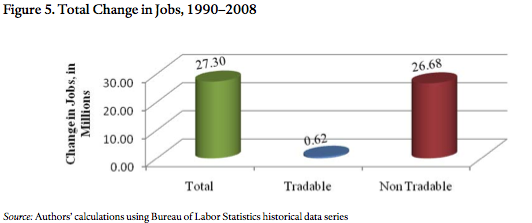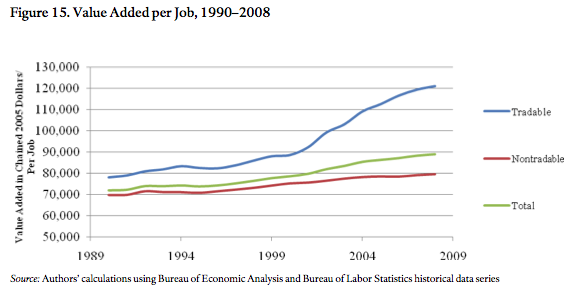I have argued before that while there is no problem with the US running fiscal deficits while its economy regains its feet, in the longer term, reviving non-financial business investment and growing exports faster than imports is the only sustainable way out of the ongoing economic slump. However, this is going to be easier said than done. A new paper by Michael Spence and Sandile Hlatshwayo, titled The Evolving Structure of the American Economy and the Employment Challenge, illustrates this point very well. The chart below shows that of the 27 million or so jobs created in the US between 2000 and 2008, almost the entire amount was in the non-tradable sector, which mainly comprises services such as government, health care and retail.

Only about 2% of the jobs created were in the tradable (export) sector. This is a bit of a disturbing trend, as it turns out, for a number of reasons. As the authors of the paper say:
Given the pressure on the government budgets, continued gains in government employment seem unlikely. Equally, health care absorbs a large enough fraction of GDP (on the order of 16 percent) that expansion in that sector is at least questionable…
Growth in other nontradable services that generated employment gains—for example, retailing—has been driven in part by debt-financed consumption. After the financial crisis, the prospects for job growth in these sectors are duller.
So to recap, virtually all the recent growth in US employment has come in domestic sectors which are unlikely to grow much further. On top of that, as the chart below shows, the nontradable sector’s value-added per job is very low compared to the export sector. So the jobs that are being generated are relatively low wage ones, which, the authors of the paper argue, is one of the big factors behind the rise in inequality seen in recent years.
While value added in the tradeable sector has been growing a lot faster, this is been mostly due to offshoring, or as the authors put it, “the out-migration of functions in global supply chains associated with lower valued added per job.” In other words, the lower value-added parts of the supply chain are moving offshore to emerging-market economies like China, leaving only the more sophisticated, high-value-added functions in the US. While this is an inevitable result of globalisation, it is not a good recipe for job creation in the US. And as emerging markets grow, they will increasingly compete for these more sophisticated functions as well, which does not bode well either for jobs or the income distribution.
Given the prospect of slowing employment growth in nontradables and rising competitive pressure on tradables, major employment problems in the near future are a certainty. Even if the nontradable sector is able to continue to absorb the growth in the labor force, pressure on wages and salaries will be downward, and consequences for income distribution unavoidable.
So what’s the answer? As is often the case, the authors of the paper are much better at identifying the problem than proposing a viable solution.
In principle, foreign demand, especially from the high-growth emerging economies could make up some of the difference. But it probably will not happen…
To create jobs, contain inequality, and reduce the U.S. current-account deficit, the scope of the export sector will need to expand. That will mean restoring and creating U.S. competitiveness in an expanded set of activities via heightened investment in human capital, technology, and hard and soft infrastructure. The challenge is how to do it most effectively.
Regarding the first point here on foreign demand, the authors are probably right that it won’t happen, at least any time soon. For foreign demand to play a bigger role, China and other emerging market economies will probably need to loosen or abandon their pegs against the US dollar and rebalance their economies towards consumption. Hence all the constant chatter from central bankers such as Ben Bernanke on global imbalances.
On the second point, the US needs to spend more on education, invest in infrastructure, provide incentives for job retraining and the acquisition of new skills, etc etc. All worthy goals. But all of these policies take time. Once manufacturing industries shift offshore — their support networks and the skilled labour that underpinned them disappear as well. Now that they are gone, bringing them back to the US will not be easy.
In the meantime, if unemployment stays high and inequality continues to rise, the easy solution will be a resort to protectionism.
In this kind of environment, politics will probably become divisive and polarized, and the inclination to use protection and market access to expand employment options will increase. Because that will undoubtedly provoke responses by other countries, the openness of the global economy will be at risk.
It looks like there aren’t going to be any easy answers.
